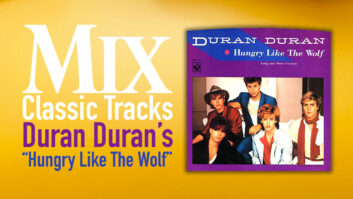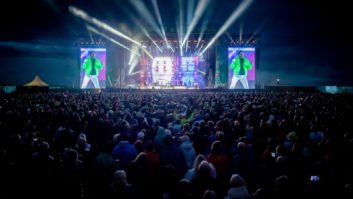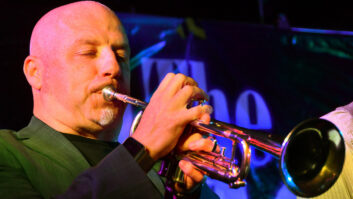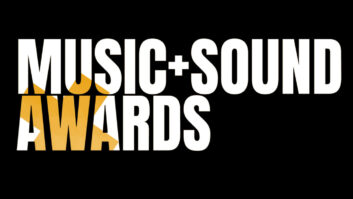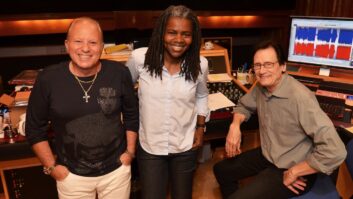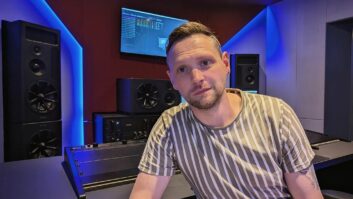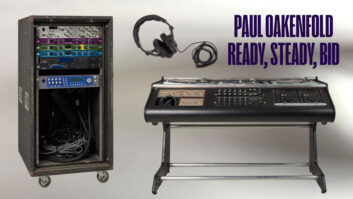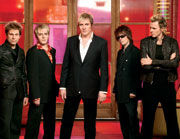

I confess: I am a former jazz shoe — wearing, button-collecting Durannie. From age 12 until my sophomore year of high school, I scoured my local mall record store for every album, single, 12-inch dance remix and picture disc I could find. Apparently, I share my obsession with good company. Dallas Austin — producer of chart-topping albums and singles for ABC (Another Bad Creation), Boyz II Men, TLC, Brandy, Monica, Fishbone and, most recently, Pink, Gwen Stefani and Janet Jackson — was also a self-described “Duran Duran nut.” But instead of cutting out Fab Five pictures from Bop magazine, Austin ogled Nick Rhodes’ keyboards.
The fab five, reunited and back on the charts (L to R): Roger Taylor, Nick Rhodes, Simon LeBon, Andy Taylor and John Taylor.
Two decades later, Rhodes, Simon LeBon and John, Roger and Andy Taylor (no relation) tapped one giddy Austin, along with Don Gilmore (Good Charlotte, Linkin Park, Sugar Ray) and Nile Rodgers (Madonna, David Bowie) to co-produce Astronaut, the band’s first studio album with all original members since their 1983 release, Seven and the Ragged Tiger.
After six sub-par, partially Duran albums, the original five got together to discuss a new album. It was the first time they had sat in a room together in 15 years. “Within five minutes, we were arguing about the same things we had the last time we were in a room together,” recalls a slightly jetlagged Rhodes from his London home. “But it quickly turned to, ‘How are we going to do the album?’ There wasn’t really much question about anything else.”
The initial plan was pretty straightforward: Record and release the album, then go on tour. In 2001, they rented a house near St. Tropez in the south of France, set up a Pro Tools studio and launched into a prolific period of songwriting and pre-production. “I knew from the moment we plugged in that there wasn’t much apprehension,” says Rhodes. “Everybody came in wanting it to work. Within minutes, we’d hit on something really great and finished a song the first evening.”

During their first 12-day writing session, the group wrote three songs that ended up on Astronaut — “Bedroom Toys,” “Taste the Summer” and “Nice” — along with the seeds for “Want You More.” After a few more sporadic but fruitful writing sessions, the group had more than 30 songs in the works. Unfortunately, when they were ready to hit the studio, the record industry was in one of its worst slumps in years.
“Every time we’d start talking to a label, the CEO would get fired or, in some cases, the whole label had disappeared!” says Rhodes. “It was becoming like a comedy sketch. Then, somebody suggested, ‘Let’s play some shows. We can test the waters and get our live show up to speed.’”
Their first “test run,” at the Budokan Arena in Japan, sold out in 30 minutes and was followed by a 25-city U.S. tour and a sold-out British tour that included five shows at London’s Wembley Arena. The New Romantics were back and they had a record to finish — pronto.
In 2003, Duran Duran inked a deal with Epic and hired producer/engineer Gilmore to work on two songs. The sessions went so well, he stayed for six weeks and co-produced and engineered eight of the album’s 12 tracks. “Don chose very carefully what needed to be done, so we ended up with all the right parts in the end,” Rhodes says. “And he was fun to have around, which is half the battle: finding [a producer] who fits the vibe and makes everyone feel good about what they are doing.”

Nick Rhodes, aka “the mad scientist”
The group recorded on the 72-channel Neve 88R at London-based Sphere Studios’ Studio One using a Pro Tools|HD workstation as a tape machine and editing tool. Designed by acoustic consultants Munro Associates, Studio One offers 5.1 monitoring via Dynaudio M4 speakers, ISDN 2 capabilities and a live room large enough to accommodate up to 35 musicians, with four fully floated isolation booths and 6-meter-high ceilings.
The group also welcomed back Rodgers (Notorious, “Wild Boys”) to co-produce “Point of No Return” and add vocal production to two tracks. “We all just love him, and we’ve worked with him before very successfully,” Rhodes says. “In truth, we probably got him in a little too early because a lot of things changed. But ‘Point of No Return’ remains in its entirety. To me, it’s one of the most beautiful moments on the album.”
Austin, whom Rhodes likens to a young Rodgers, co-produced three songs, including two of the album’s brightest spots: “Want You More” and “Astronaut.” “[Dallas] said, ‘I want to stack up the harmonies,’” recalls Rhodes. “‘I want that uplifting sound that you always had in those big Duran Duran choruses.’” Austin adds, “I wanted to bring back that groove they had, but make them sound modern and hip at the same time.”
Austin accomplished the task by not only using his Grammy-winning production skills, but by throwing a bash in their honor. “The lights were completely down, wine bottles were piling up and there was gear…everywhere! Mountains of gear,” Rhodes recalls. “It was really party time for us, and I think that shows in the tracks we worked on with him.”

Roger Taylor, the “rock solid” D2 drummer
Rhodes’ all-analog synth cache includes many used on Duran Duran’s first albums, such as the Roland Jupiter8, Sequential Circuits Prophet-5 and the Memorymoog. He also uses the Minimoog and admits to “quite liking” the microKORG synthesizer/vocoder. “But I used the original Roland vocoder on ‘Nice,’” he says, “and I process a lot of things through cheap, nasty pedals.”
“He had so many things I’d never seen in my life before,” Austin adds. “He’d pop in with a different keyboard and go, ‘Look at this! What do you think about this!’ He’s like the mad scientist of analog keyboards!”
Austin usually brings his own keyboard collection to sessions; he and engineer Rick Sheppard have been known to travel with 7,800 pounds of gear stripped from Austin’s DARP Studios in Atlanta. However, due to time and customs constraints, the duo brought only two laptops and two 250-gig hard drives loaded with Sheppard’s entire library — sounds he’s collected as Austin’s programmer and engineer for the past 15 years.
With Austin onboard, “Astronaut” evolved from a ballad to an assured dance-pop hit. “I said, ‘Can I just take it and put it on speed?’” recalls Austin. “They re-wrote the verses and took it in another direction. When they finished, we were like, ‘Whoa!’ It became the title track for the album.”
Sheppard recorded the band through Sphere’s Neve to a Pro Tools|HD4 with Logic Audio on the front end. They had rented Pro Tools|HD and HD3 units, but both lacked the processing power needed to handle Sheppard’s massive library. “I use [Tascam] GigaStudio for my sample library,” he says. “I run that on a PC and run Logic on the Mac, so I just use the PC as a sampler. I have a couple hundred thousand .WAV files and tons of Gig files — I pretty much own all the Gig libraries out there — plus I converted all my Akai libraries to CD-ROM.”

Simon LeBon working the mic
Needless to say, Sheppard uses more plug-ins than outboard gear. Aside from the Neve’s EQs and effects, an API 500-6B Lunchbox EQ and a Universal Audio 6176 for LeBon’s vocals, Sheppard relied mainly on SoundToys, McDSP and Emagic’s Logic plug-ins. LeBon sang through a Neumann TLM 103. “It sounded crisp and clear with the UA 6176,” he says. “I put it on the One setting to give it color. I set a Mac flat screen on top of the 6176, so I have it right by my keyboard.”
Andy Taylor’s guitars were miked with a Shure SM57 through a Peavey amp. Other times, Taylor used Line 6’s Variax guitar modeling tool, sent through Line 6’s Vetta II tube amp and the PODxt.
Sheppard used a standard mic setup for Roger Taylor’s drums, choosing Sennheiser 421s, AKG C 414s and a modified, custom-made Audix sub kick mic. “We take a [Yamaha] NS-10 subwoofer, lead it to an XLR and run it through an attenuator,” says Sheppard. “It gives you a lot of low-end thump.”
Rhodes, known as “the vampire” of the group because of his night owl tendencies and preference for dark control rooms, often spends several days going through sounds and layering keyboard parts with his technician, Mark Tinley. “I see what fits where, what melodies need to be doubled up or what snare drums need an extra little crack on top of them,” Rhodes says. “Andy will see if he can double my parts, and I’ll see if he needs chords under his rhythms. Then, once we’ve got a track we’re really happy with, I’ll work on detail again.” Sheppard adds, “Nick is so into coming up with something different and innovative and spends the time to make a patch and not just use what’s stock.”
Rhodes and the rest of the group’s tweaking continued well into mix mode, which was handled by Jeremy Wheatley (David Gahan, Sugarbabes, Dandy Warhols) at Sanctuary Town House Studios and Olympic Studios, both in London. “He really had an enormous input,” Rhodes says of Wheatley. “He makes things sound so lush, and feel as though in cinemascope — very exciting, dynamic and warm all at the same time.”
Wheatley had his work cut out for him; most songs contained more than 100 tracks, some of which dated back three years. To further complicate matters, the band had to listen to and approve mixes via edNET due to a series of U.S. radio promotions that took place in the middle of mixing. “We were running all over America, and in each city we hooked up the satellite link and directly listened to the mixes live and tweaked everything like that,” says Rhodes. “On some songs, we completely changed things at the last minute. John and I changed the whole vibe of verse two of ‘Bedroom Toys’ with Jeremy over the edNET system.”
Astronaut dropped to Planet Earth on October 12, along with a limited-edition “deluxe” DVD. Based on the positive reviews and rapid-fire arena sellouts, Birmingham, England’s pretty boys have got more than nostalgia on their side. “They’re model is that they’re only as strong as their weakest link, so if somebody doesn’t like [a part], they work it out,” says Austin. “Everybody had a goal to stand up to their legacy,” Sheppard adds. “Besides the lack of sleep and 18 hour days, it was a really great experience.”

Click here to see more pics of the Fab Five in-studio!
Listen to clips from Duran Duran’s new album, Astronaut
1. “(Reach Up For The) Sunrise” produced by Don Gilmore and Duran Duran
2. “Astronaut” Dallas Austin and Duran Duran
3. “Want You More” produced by Duran Duran, Don Gilmore and Dallas Austin
